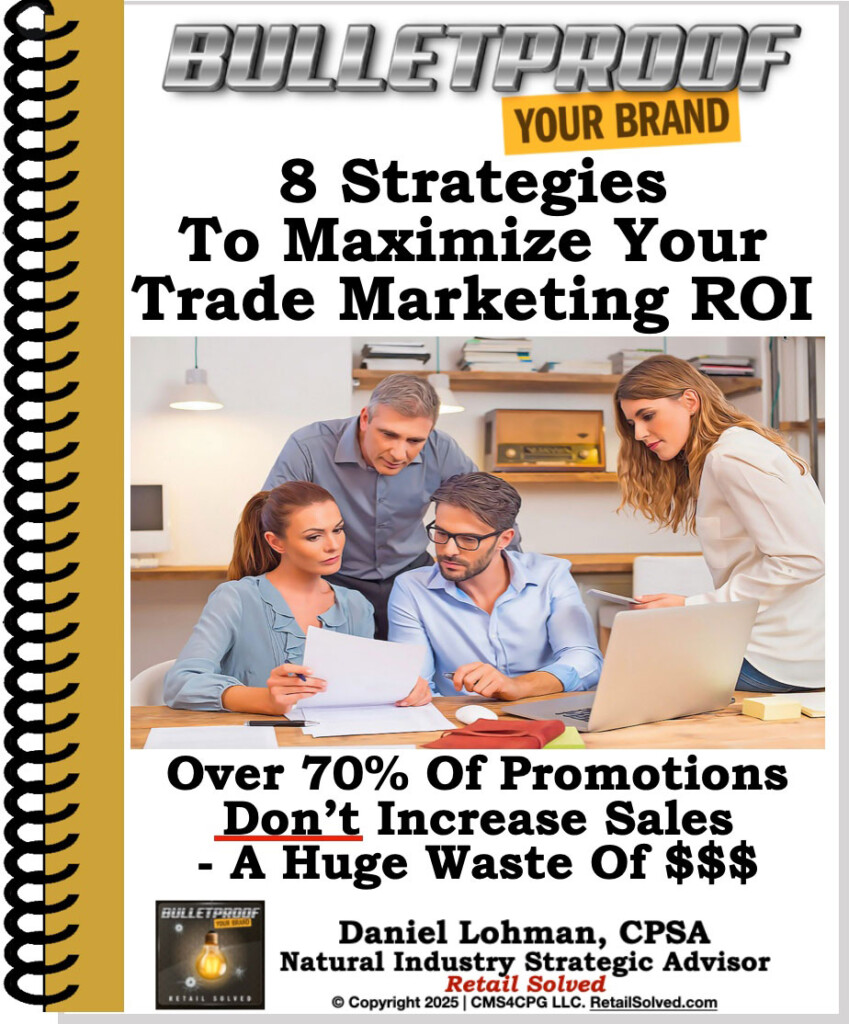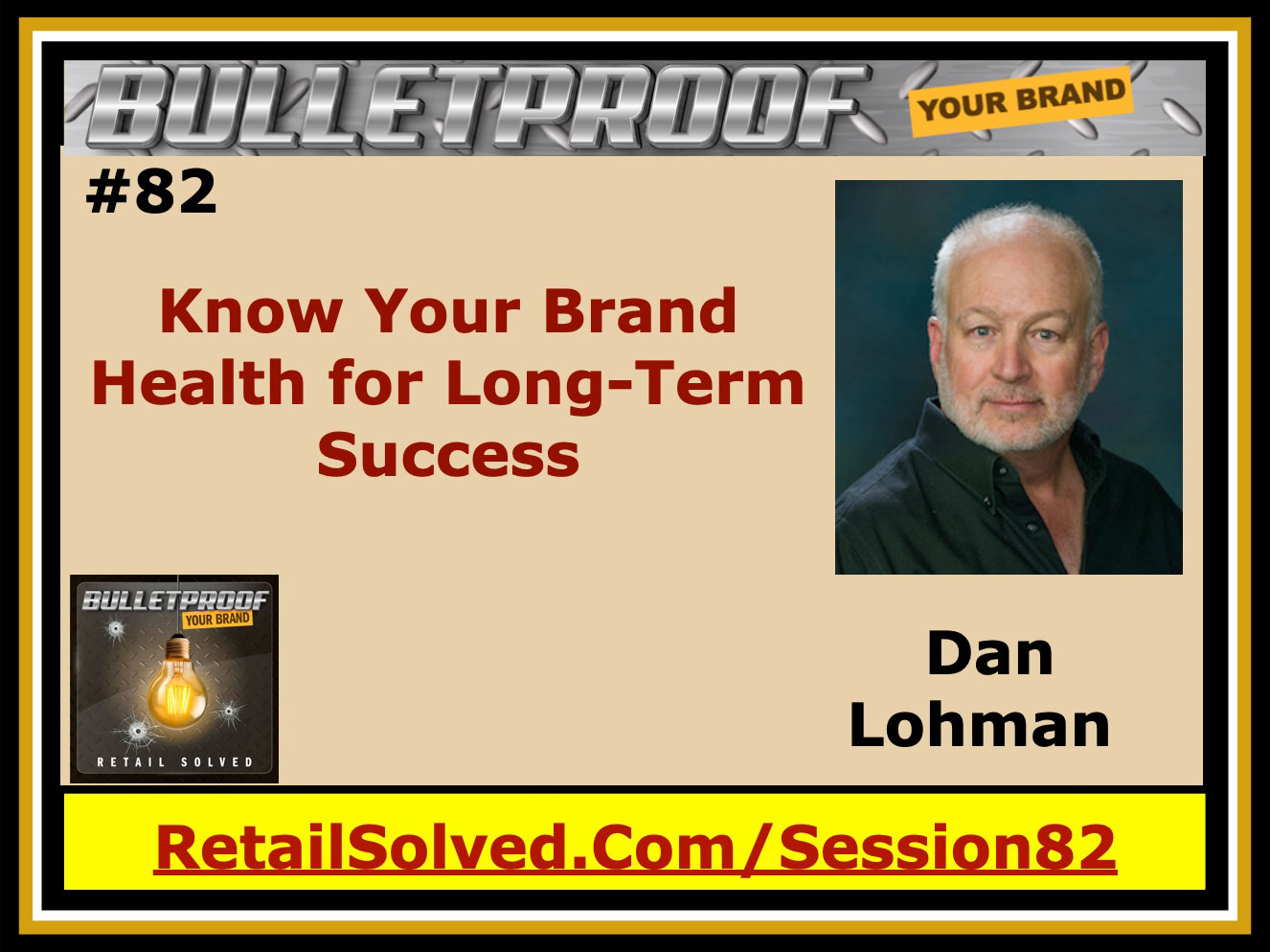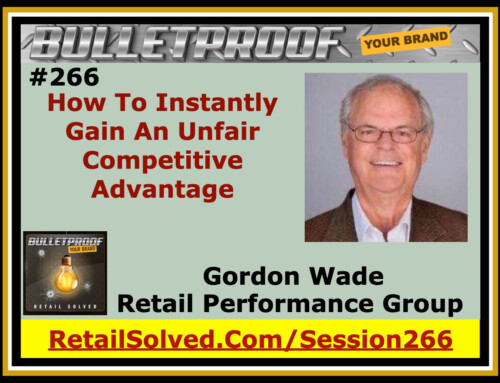Explore ways to know your brand health and boost your brand strategy for better performance and sales growth. The health of a brand is measured by its ability to drive profitable sales at retail, not by the size of its bank account. Promotions build awareness and drive sales, most are ineffective and can dilute brand health. Small brands need to communicate the value of their products to consumers through personalized relationships and digital marketing, focusing on attracting new customers rather than relying solely on promotions.
Is your brand strategy to run a sprint or a marathon? Knowing the health of your brand will help you gauge your stamina and help you reduce the risk of a heart attack. Healthy brands live longer requiring less capital and giving you more runway to grow sales.
Listen where you get your podcast
Important: Brand Secrets and Strategies has been rebranded to Retail Solved. Please swap all BrandSecretsandStrategies.com URL’s with RetailSolved.com. This is now the Bulletproof Your Brand podcast. Thank you for listening! BRAND SECRETS AND STRATEGIES PODCAST #82 Hello and thank you for joining us today. This is the Brand Secrets and Strategies Podcast #82 Welcome to the Brand Secrets and Strategies podcast where the focus is on empowering brands and raising the bar. I’m your host Dan Lohman. This weekly show is dedicated to getting your brand on the shelf and keeping it there. Get ready to learn actionable insights and strategic solutions to grow your brand and save you valuable time and money. LETS ROLL UP OUR SLEEVES AND GET STARTED! Welcome. I appreciate your listening. I hope you're enjoying this podcast. Remember its about you and it's for you. I appreciate all the great feedback and comments. If you like the podcast, please share it, subscribe and leave a review on iTunes. Don't forget that there's a free downloadable guide at the end of most every episode. I was tried include one easy to download, quick to digest strategy that you can easily adopt and make your own - one that you can use to grow sustainable sales and compete more effectively. Remember the goal here is onto get your product on more retailer shelves and into the hands of more shoppers. Here's today's story. Do you know how healthy your brand is? Few brands can answer this question with certainty. I'm not asking you if you have a lot of money in the bank. I'm asking do you know how much your brand contributes to the category and your company's overall health? Let me explain. Retailers want their shelves filled with healthy brands that deliver consistent sales growth and more shoppers. Any brand with deep pockets can artificially grow sales through deep discounts and promotions. This strategy however, is not sustainable, and more importantly, it frequently dilutes category growth. Those brands are typically here today and gone tomorrow. Retail is a marathon, not a sprint. You worked hard to build your brand, now you want to see it grow and flourish. Knowing your brand's health is the critical first step in building a legacy brand. Leveraging the health of your brand in your selling story with retailers establishes your commitment to helping them compete more effectively in their market. The health of your brand, or your contribution, is what retailers “take to the bank”. The size of your bank account has little reflection on the health of your brand. The health of your brand is measured by its ability to drive profitable sales at retail - period. Let's face it, retail is expensive. It cost a lot of money to get your product onto retailer shelves. A lot of brands think that their brand is healthy if they have money to pay for slotting, promotions, price reductions, displays, deductions, marketing, and to advertise in retailer’s weekly circulars. Most brands chalk this up to the cost of doing business. Sadly, most promotions lack creativity focusing instead on the unreliable and unsustainable rinse and repeat strategy. What if I told you that there is something far more important and effective than repeatedly throwing money at promotions to grow your brand? There is a better way. You've probably heard it said before that sales solve all problems. That's not entirely true. Knowing the health of your brand requires that you know the difference between what fuels sustainable growth compared to the quick wins. Again, is your brand strategy to run a sprint or compete in a marathon? This is where knowing how to assess the health of your brand can make all the difference between you being a one hit wonder and a legacy brand. This is where knowing the health of your brand can be the difference of focusing on the things that grow sales as opposed to being a perpetual fundraiser. One of the most important components of sales are promotions. You need to promote your products to build brand awareness, attract new customers, and drive sales. The problem is that most promotions are ineffective and do little to accomplish those objectives. What’s worse is that they can dilute the health of your brand. This balancing act is where most brands struggle. Do you participate in every promotion a retailer or distributor has or do you focus only on the promotions that deliver the highest return on your investment? Sounds like a no brainer but some retailers and distributors place a lot of pressure on brands to participate in promotions that achieve very little if any real growth. This is a subject for a future podcast. The real health of your brand to a retailer is not measured by how often you promote your products but rather the value of the customer that you drive into their store. Retailers want two things, more traffic in their stores and a reasonable profit. Brands that can help them achieve these goals have a distinct and sustainable competitive advantage. We continually hear “experts” tell us that price is the only driver to motivate customers to buy your product. This is not true. If it were, then luxury and decadent items would all be declining in sales. Instead, they are growing exponentially. The reality is that consumers are willing to spend money on products that meet their wants and needs. Consumers today are better educated about the products they purchase. They have the ability to instantly research a product on their smart phone while standing in front the retailer’s store shelf. They can learn all about the product, its origin, its level of transparency, the quality of the ingredients used to produce it, they can get reviews from other customers, recipes, compare prices, and they can even get product reviews from trusted influencers. This is a huge game changer, especially for small brands. Brands now have the ability to communicate the value of their products to a broad audience without having to rely on a huge marketing budget. This is helping to level the playing field between small brands and big brands. One of the things that makes small natural organic brands unique, is their ability to have a more intimate relationship with their customers. They know how to talk to them. They are able to have a conversation with them through social media and digital marketing. More importantly, they become a trusted part of their customer’s communities. In other words, they have a personalized one-on-one relationship with their customers. Big brands, on the other hand, tend to spend most of their efforts talking at us and not to us. They use their megaphone to share the same message with everybody. They tend to commoditize customers and products, not appreciating that a one-size-fits-all approach lacks the authenticity that customers demand today. A brand’s digital strategy needs to focus on driving new customers to try your products. That needs to be the focus of every promotion - attracting new customers. There are more effective and efficient ways to reward your existing loyal customers than through traditional promotional strategies. This is a subject that I will cover more in-depth in a future podcast and course. One of the ways you measure the health of your brand at retail is by focusing on what you contribute to the category at each store. Your contribution is measured by your sales velocity in the stores your product is selling. Simply using total retailer sales will not work as no two stores are alike. This is where things begin to get complicated, but don’t worry, I’m here to untangle and simplify this for you. For starters, we need to draw a line in the sand. We need a benchmark to compare to. While the best benchmark is typically comparing your brand to the overall category, sometimes it's important to also compare yourself to target competitive brands. Next, we need a way to compare sales by store. Since some stores have a greater sales velocity than others, the most effective way to do this is to weight them based on their overall performance by their sales. This is where ACV, all commodity volume, comes in. ACV is how we measure the health of your products. ACV measures the depth, and breath of your products sales by individual store. Let me explain. The other key component of sales is distribution. The breath of your product’s distribution is the number of stores your products are sold in. The depth of your products sales is measured by the weight of each store your products are sold in. Let me simplify this. The breath of your distribution is the number of stores your product is being sold in by retailer. Remember I said that not all two stores are equal? The depth of your product’s sales is weighted by the value of each store within the retailer. A store with twice the sales volume of their sister stores is weighted at two times their volume. In other words, it’s reasonable to expect two times the sales at that store compared their sister stores. This is where things begin to get to complicated for a podcast. For this reason, I am in the process of building a mini-course complete with pictures and examples to help illustrate how all this works. It's important that you understand the components of contribution as you begin to assess the health of your brand. The course will be live shortly after Expo East 2018. I'll also dig into the difference between ACV, max ACV, and TDP - total distribution points. How they're calculated and how you can use these measures to compete more effectively at retail. Future courses will teach you how to measure the effectiveness of your promotions. For now, we'll talk about the measures you need to focus on and skip over the calculations leaving them to the mini course. It's important to note that you cannot add ACV and that you really need to capture your brand’s ACV directly from the syndicated database in order for it to be accurate. The key measures you need to focus on is your contribution. The calculation is dollar sales (or units) divided by %ACV distribution. Contribution is measured by your dollars per point of distribution commonly referred to as $SPP and units per point of distribution commonly referred to as unitsPP. Use dollars per point of distribution as your primary measure for premium and super premium products like natural organics. Use units per point of distribution for economy products including private label. Dollars per point of distribution are what you take to the bank so we'll use that going forward. The biggest driver of contribution is your ability to sell your product without promoting it. In other words, if you can get shoppers to buy your product at your regular price every day then your contribution will be higher as a result. This is why it's important understand how to measure the health of your brand. This helps you gauge how effective your promotions are and how efficient your promotion strategy is. The quickest and easiest way to assess the health of your brand is to compare your contribution against the total category and your competitors. Contribution measures the amount of dollars that your brand brings to the category. If your contribution is higher then the total category of any competitor, that means that your brand is contributing more to the profits of the category. Another way to put this is that your brand is responsible for driving healthy sales growth in your category. When you compare your contribution to your competition, this helps you tell the story leveraging the importance of your brand to the category in contrast to other brands. Remember that everything is negotiable at retail. In my free Turnkey Sales Story Strategies Course, I teach you how to build your selling story while leveraging all of the important things that help you stand out against your competition. Highlighting the fact that you contribute more to the categories than other brands is an important part of your selling story. This is something that you need to reinforce with retailers to help them appreciate the hard work you're doing driving profits into other categories. Pro tip: Measuring the contribution of your products focusing on your unique selling proposition is where you typically see the greatest or the highest contribution. For example, if you sell organic products, then comparing your contribution to other organic products in the category is going to help you stand out. You can also use this strategy when focusing on other attributes like plant-based, gluten-free, non-GMO, etc. Savvy retailers want and need brands willing and able to take a leadership role in their category. This means that any brand that can drive sustainable category growth will have a significant competitive advantage. There's no better way to measure your impact on overall category sales than to focus on what your brand contributes. Knowing how to measure the health of your brand is critical to your brand's longevity. Developing strategies that improve your ability to contribute to the retailer’s category should be the focus of every brand. This is where you need to know your numbers and why it's important to use the advanced strategies we talk about on this podcast, in my articles, and in my courses. Remember the goal is to get your products onto more retailer shelves and into the hands of more shoppers. This is how we make our healthy way of life more accessible. Knowing how to measure the health of your brand also allows you to focus on your mission, new product innovation, and other opportunities to grow and improve your products. It also allows you to focus on your brand’s messaging which may include switching to sustainable packaging, committing to clean label ingredients, adopting renewable energy, and much much more. I believe that CEOs should not be perpetual fund raisers. These strategies will help you get more runway to grow your brand and thrive. Thank you for listening. I'll be sure to put a link to this week’s podcast show notes on this podcast webpage. You can get there by going to brandsecretsandstrategies.com/session82. Todays free downloadable guide is my 8 Strategies To Maximize Trade Marketing ROI. You can get it on this podcast webpage. I look forward to seeing you in the next episode. This episode's FREE downloadable guide Most promotional spending is ineffective and wasted. Effective promotions expand runway, grow sustainable sales & maximize your promotional ROI. CLICK HERE TO DOWNLOAD YOUR FREE STRATEGIC GUIDE: 8 Strategies To Maximize Trade Marketing ROI Thanks again for joining us today. Make sure to stop over at brandsecretsandstrategies.com for the show notes along with more great brand building articles and resources. Check out my free course Turnkey Sales Story Strategies, your roadmap to success. You can find that on my website or at TurnkeySalesStoryStrategies.com/growsales. Please subscribe to the podcast, leave a review, and recommend it to your friends and colleagues. Sign up for my newsletter today on my website so that you don’t miss out on actionable insights and strategic solutions to grow your brand and save you valuable time and money. I appreciate all the positive feedback. Keep your suggestions coming. Until next time, this is Dan Lohman with Brand Secrets and Strategies where the focus is on empowering brands and raising the bar.
Enter your name and email address below and I'll send you periodic updates about the podcast.
Sign up to receive email updates
FREE Trade Promotion ROI Calculator:
Click Here To Maximize Sales And Profits

8 Strategies To Maximize Trade Marketing ROI
Want 8 Proven Strategies To Maximize Trade Marketing ROI?
Tired of wasting money? Most promotional spending is ineffective and wasted. Effective promotions expand your runway, make your brand more attractive to investors, grow sustainable sales & maximize your promotional ROI. Trade marketing typically represents about 25% of your gross sales and yet 70% of it is often wasted or ineffective. Learn simple strategies to fix this and put more cash in your pocket to grow and scale your brand.
Add button
A personal note to all podcast listeners
Hello and thank you for coming to this page.
I am in the process of rebranding.
I competed updating and improving every podcast episode and all are live now.
I am currently working as fast as I can to update and republish all 268 podcast pages on this website.
Making the guide links live are the next thing on my list after that so please keep checking back.
Also, please stay tuned for podcast episode 269 where I will reveal what to expect from the show and what you can expect from me going forward – plus you'll get to see the new podcast image!
I have a lot go great things planned to help you confidently grow and scale your brand including new episodes, videos, guides, courses, and much much more.
Thanks for your patience. I am working as fast as I can to get everything up an running.
Daniel
Image is the property of CMS4CPG LLC, distribution or reproduction is expressively prohibited.














